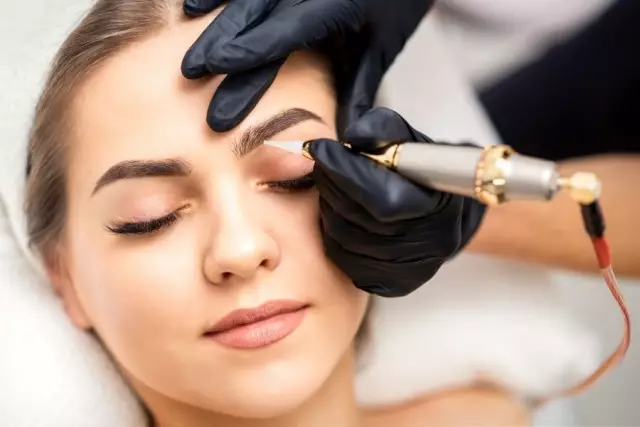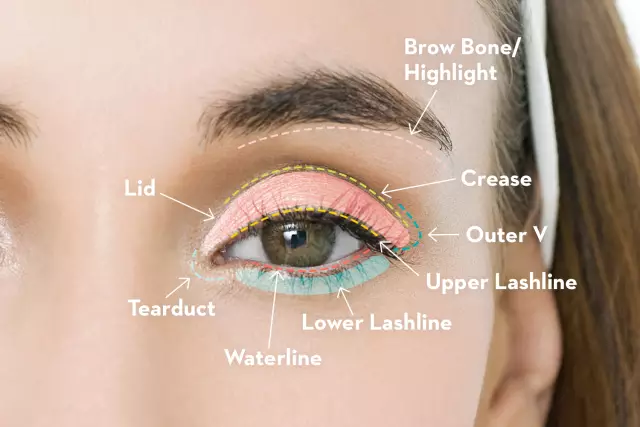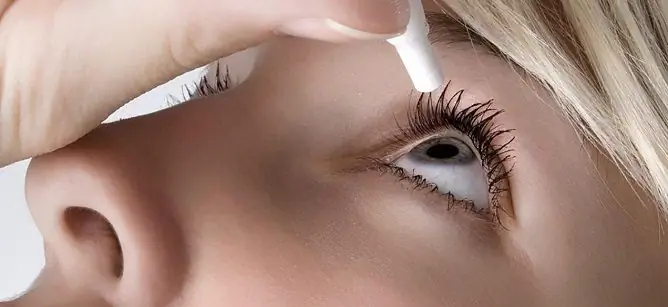- Author Rachel Wainwright [email protected].
- Public 2023-12-15 07:39.
- Last modified 2025-11-02 20:14.
Timolol
Timolol: instructions for use and reviews
- 1. Release form and composition
- 2. Pharmacological properties
- 3. Indications for use
- 4. Contraindications
- 5. Method of application and dosage
- 6. Side effects
- 7. Overdose
- 8. Special instructions
- 9. Drug interactions
- 10. Analogs
- 11. Terms and conditions of storage
- 12. Terms of dispensing from pharmacies
- 13. Reviews
- 14. Price in pharmacies
Latin name: Timolol
ATX code: S01ED01
Active ingredient: Timolol
Manufacturer: MICRO LABS (India), SLAVYANSKAYA PHARMACY (Russia), SC ROMPHARM Company (Romania), UPDATE (Russia), BELMEDPREPARATY (Republic of Belarus), SINTEZ (Russia), BETA-LEC (Russia), LENS-PHARM (Russia), MOSCOW ENDOCRINE PLANT (Russia), URSAPHARM Arzneimittel (Germany), Teva Pharmaceutical Industries (Israel)
Description and photo update: 2019-12-08
Prices in pharmacies: from 20 rubles.
Buy

Timolol is a topical beta-blocker, antiglaucoma drug.
Release form and composition
Dosage form - eye drops 0.25% and 0.5%: transparent colorless liquid (0.25%: 1 ml, 1.5 ml, 2 ml or 5 ml each in a dropper tube, in a cardboard box 1, 2, 5, 10, 50 or 100 pcs.; 5 ml or 10 ml in a bottle, in a cardboard box 1, 5 or 50 pcs. Complete with a dropper; 5 ml in a glass bottle of dark color or 10 ml in a bottle, in a cardboard box 1, 5 or 50 pcs.; 1 ml in a tube-dropper, in a blister pack 2 pcs., In a cardboard box 1 package; 5 ml in a bottle with a dropper stopper, in a cardboard box 1 pc.; 0.5%: 1 ml, 1.5 ml, 2 ml or 5 ml each in a dropper tube, in a cardboard box 1, 2, 5, 10, 50 or 100 pcs.; 10 ml each in a polymer dropper bottle, in a cardboard box 1, 2, 5, 10, 50 or 100 pcs.; 1 ml each in a dropper tube, in a blister strip packaging 2 pcs., In a cardboard box 1 package;5 ml in a bottle with a dropper cap, in a cardboard box 1 pc.; 5 ml or 10 ml in a bottle, in a cardboard box 1, 5 or 50 bottles complete with a dropper; 5 ml or 10 ml in a bottle, in a cardboard box 1, 5 or 50 pcs.).
1 ml drops contain:
- active substance: timolol maleate - 3.4 mg (0.25%) or 6.8 mg (0.5%), which is equivalent to 2.5 mg or 5 mg of timolol, respectively;
- auxiliary components: sodium chloride, disodium phosphate dodecahydrate, benzalkonium chloride, sodium dihydrogen phosphate monohydrate, sodium hydroxide, disodium edetate dihydrate, purified water.
Pharmacological properties
Pharmacodynamics
Timolol is a non-selective beta-adrenergic receptor blocker with no sympathomimetic activity. When applied topically, it helps to reduce intraocular pressure by reducing the production of aqueous humor and slightly increasing its outflow. By lowering intraocular pressure, it does not affect pupil size and accommodation, as a result of which there is no deterioration in visual acuity or a decrease in the quality of night vision. The drug begins to act 20 minutes after instillation, and the maximum therapeutic effect is noted after 1-2 hours. Timolol lasts 24 hours.
Pharmacokinetics
Timolol penetrates the cornea into the eye tissue at a high speed. After it gets into the moisture of the anterior chamber of the eye, the maximum concentration of the substance in the blood plasma is recorded after 1-2 hours. A small amount enters the systemic circulation, being absorbed through the mucous membranes of the lacrimal tract and nose, as well as through the conjunctiva.
The maximum level of timolol in blood plasma is approximately 0.824 ng / ml and remains up to the detection threshold for 12 hours. In newborns and young children, its maximum concentration in blood plasma significantly exceeds that in adults. The half-life of timolol when applied topically is 4.8 hours. It is metabolized in two ways, forming either an ethanolamine side chain on the thiadiazole ring to form an ethanol side chain linked to the nitrogen of morpholine, or a similar side chain with a carbonyl group linked to nitrogen. The isoenzyme CYP2D6 is involved in metabolic processes. The substance and its metabolites are excreted mainly in the urine, with approximately 20% of timolol excreted unchanged.
Indications for use
- significant increase in ophthalmotonus;
- open-angle glaucoma;
- angle-closure glaucoma (as part of combination therapy with miotics);
- secondary glaucoma, including uveal, post-traumatic, aphakic.
Contraindications
- rhinitis;
- degenerative diseases of the cornea;
- bronchial asthma;
- sinus bradycardia;
- acute or chronic form of heart failure;
- atrioventricular (AV) block II and III degree;
- cardiogenic shock;
- period of breastfeeding;
- hypersensitivity to the components of the drug.
According to the instructions, Timolol should be prescribed with caution to patients with arterial hypotension, sinoatrial blockade, chronic heart failure, cerebrovascular insufficiency, hypoglycemia, diabetes mellitus, myasthenia gravis, thyrotoxicosis, in severe chronic obstructive pulmonary disease, concomitant therapy with other beta-adrenergic blockers, especially for newborns (due to the content of benzalkonium chloride).
The use of drops during pregnancy is possible if, in the opinion of the doctor, the therapeutic effect for the mother is higher than the potential risk for the fetus.
Instructions for the use of Timolol: method and dosage
Timolol eye drops are intended for topical application by instillation into the conjunctival sac of the eye.
Recommended dosage:
- children under the age of 10, including newborns: 0.25% solution - 1 drop 2 times a day;
- patients over the age of 10 years: 0.25% solution - 1 drop 2 times a day. In the absence of a sufficient clinical effect, a 0.5% solution is used - 1 drop 2 times a day. After normalization of intraocular pressure, the patient is transferred to the use of a 0.25% solution in a maintenance dose of 1 drop 1 time per day.
Side effects
- on the part of the organ of vision: burning, itching, hyperemia of the skin of the eyelids and conjunctiva, conjunctivitis, lacrimation, photophobia, decreased tearing, edema of the corneal epithelium, blepharitis, transient visual acuity; against the background of long-term therapy - a decrease in the transparency of the cornea (superficial punctate keratopathy), ptosis, a decrease in the sensitivity of the cornea; rarely - diplopia;
- on the part of the cardiovascular system: lowering blood pressure (BP), bradyarrhythmia, bradycardia, decreased myocardial contractility, heart failure, AV blockade, chest pain, transient cerebrovascular accident, cardiac arrest, collapse;
- from the nervous system: drowsiness, dizziness, headache, hallucinations, decreased speed of psychomotor reactions, paresthesia, depression;
- from the reproductive system: decreased potency, sexual dysfunction;
- from the respiratory system: nasal congestion, rhinitis, epistaxis, bronchospasm, shortness of breath, pulmonary insufficiency;
- from the digestive system: diarrhea, nausea, vomiting;
- others: muscle weakness, ringing in the ears, urticaria.
Overdose
When applied topically in therapeutic doses, cases of overdose are practically not encountered.
In case of accidental oral administration, symptoms such as bradycardia, decreased blood pressure, headache, dizziness, nausea, vomiting, bronchospasm may appear. In this case, symptomatic therapy is prescribed. Dobutamine is used to treat arterial hypotension, and isoprenaline is administered intravenously to eliminate bronchospasm or severe bradycardia.
special instructions
The clinical effect of the drug should be evaluated after about one month of therapy. Treatment must be accompanied by regular (at least once every 6 months) monitoring the integrity of the cornea, tear function, visual field.
Do not use two beta-blockers for instillation in the eye at the same time.
During the period of treatment, it is not recommended to use soft contact lenses, since the presence of benzalkonium chloride in the preservative can cause adsorption on their surface. Hard contact lenses must be removed before each instillation and put on 15 or more minutes after the procedure.
Long-term use of the drug can weaken the therapeutic effect of the drug.
When prescribing Timolol eye drops, it may be necessary to correct refraction.
With concomitant therapy with antihypertensive and psychoactive drugs, glucocorticosteroids (GCS), Timolol should be prescribed with caution.
The simultaneous use of antipsychotic (neuroleptics) and anxiolytic (tranquilizers) drugs is contraindicated.
In case of planned surgical intervention using general anesthesia, instillation of the drug should be stopped 2 days before the operation.
Since for some time after instillation, a decrease in the speed of psychomotor reactions and visual acuity is possible, during the period of treatment, the patient is advised to be careful when driving vehicles, other mechanisms or performing potentially hazardous activities that require increased concentration of attention.
Drug interactions
With the simultaneous use of Timolol:
- beta-blockers of a systemic nature, epinephrine, pilocarpine cause an increase in its action;
- reserpine can contribute to the development of arterial hypotension or severe bradycardia, therefore, this combination requires careful medical supervision;
- calcium channel blockers, cardiac glycosides can cause arterial hypotension, AV conduction disturbances, acute left ventricular failure;
- muscle relaxants enhance their effect;
- local anesthetics increase the risk of their negative effects on the cardiovascular system;
- ethanol can cause a sharp drop in blood pressure.
Analogs
Timolol analogs are: Kuzimolol, Arutimol, Unitimolol, Oftan Timolol, Glaumol, Iotim, Normatin, Okumed, Niolol, Okuril, Oftimol.
Terms and conditions of storage
Keep out of the reach of children.
Store at temperatures up to 25 ° C, protected from moisture and light.
The shelf life is 3 years.
Terms of dispensing from pharmacies
Dispensed by prescription.
Reviews about Timolol
Reviews of Timolol indicate that an inexpensive drug is good at reducing eye pressure (especially in glaucoma) and eliminates pain in the eyes, thus preventing visual impairment.
However, there are also negative opinions about these eye drops. Patients mention some unpleasant side effects, as well as the development of an addictive syndrome (the drug helps worse over time).
Price for Timolol in pharmacies
The approximate price for Timolol 0.25% is 25-27 rubles (the bottle contains 5 ml). You can buy 0.5% drops on average for 26-32 rubles (for a bottle of 5 ml).
Timolol: prices in online pharmacies
|
Drug name Price Pharmacy |
|
Timolol eye drops 0.5% 10ml RUB 20 Buy |
|
Timolol 0.5% eye drops 10 ml 1 pc. RUB 20 Buy |
|
Timolol 0.25% eye drops 5 ml 1 pc. RUB 21 Buy |
|
Timolol 0.5% eye drops 5 ml 1 pc. RUB 24 Buy |
|
Timolol 0.5% eye drops 5 ml 1 pc. RUB 26 Buy |
|
Oftan Timolol 0.5% eye drops 5 ml 1 pc. RUB 40 Buy |
|
Timolol 0.5% eye drops 5 ml 1 pc. RUB 49 Buy |
|
Oftan Timolol eye drops 0.5% 5ml RUB 56 Buy |
|
Oftan Timolol 0.25% eye drops 5 ml 1 pc. RUB 65 Buy |
| See all offers from pharmacies |

Maria Kulkes Medical journalist About the author
Education: First Moscow State Medical University named after I. M. Sechenov, specialty "General Medicine".
Information about the drug is generalized, provided for informational purposes only and does not replace the official instructions. Self-medication is hazardous to health!






